List of Japanese dishes
This article has multiple issues. Please help improve it or discuss these issues on the talk page. (Learn how and when to remove these template messages)
|
Below is a list of dishes found in Japanese cuisine
Rice dishes (ご飯物)




- Gohan or Meshi: plainly cooked white rice. It is such a staple that the terms gohan and meshi are also used to refer meals in general, such as Asa gohan/meshi (朝御飯, 朝飯, breakfast), Hiru gohan/meshi (昼御飯, 昼飯, lunch), and Ban gohan/meshi (晩御飯, 晩飯, dinner). Also, raw rice is called kome (米, rice), while cooked rice is gohan (ご飯, [cooked] rice). Nori (海苔), and furikake (ふりかけ) are popular condiments in Japanese breakfast. Some alternatives are:
- Genmai gohan (玄米御飯): brown rice
- Okowa (おこわ): cooked glutinous rice
- Mugi gohan/Mugi meshi (麦御飯, 麦飯): white rice cooked with barley
- Tamago kake gohan (卵掛け御飯): Rice with a raw egg
- Ochazuke (御茶漬け): hot green tea or dashi (出汁) poured over cooked white rice, often with various savory ingredients such as umeboshi (梅干) or tsukemono (漬物).
- Onigiri (おにぎり): balls of rice with a filling in the middle. Japanese equivalent of sandwiches.
- Takikomi gohan (炊き込み御飯): Japanese-style pilaf cooked with various ingredients and flavored with soy, dashi, etc.
- Kamameshi (釜飯): rice topped with vegetables and chicken or seafood, then baked in an individual-sized pot
- Sekihan (赤飯): white rice cooked with azuki beans (小豆) to Glutinous rice. (literally red rice)
- Curry rice (karē raisu カレーライス): Introduced from the UK in the late 19th century, "curry rice" is now one of the most popular dishes in Japan. It is much milder than its Indian counterpart.
- Hayashi rice (ハヤシライス): thick beef stew on rice
- Omurice (Omu-raisu, オムライス): omelet filled with fried rice, apparently originating from Tōkyō
- Mochi (餅): glutinous rice cake
- Chāhan (炒飯): fried rice, adapted to Japanese tastes, tends to be lighter in flavour and style than the Chinese version from which it is derived
Congee (お粥)
- Kayu or Okayu (粥, お粥): rice congee (porridge), sometimes egg dropped and usually served to infants and sick people as easily digestible meals
- Zosui (Zōsui, 雑炊) or Ojiya (おじや): a soup containing rice stewed in stock, often with egg, meat, seafood, vegetables or mushroom, and flavoured with miso or soy. Known as juushii in Okinawa. Some similarity to risotto and Kayu though Zosui uses cooked rice, as the difference is that kayu is made from raw rice.
Donburi (どんぶり)
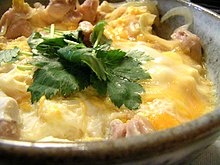
A one-bowl dish, consisting of a donburi (どんぶり, 丼, big bowl) full of hot steamed rice with various savory toppings:
- Katsudon (カツ丼): donburi topped with deep-fried breaded cutlet of pork (tonkatsudon), chicken (chickendon)
- Tekkadon (鉄火丼): donburi topped with tuna sashimi
- Oyakodon (親子丼): donburi topped with chicken and egg (or sometimes salmon and salmon roe) (literally Parent and Child bowl)
- Gyūdon: (牛丼): donburi topped with seasoned beef
- Tendon: (天丼): donburi topped with tempura (battered shrimp and vegetables).
- Unadon: (うな丼, 鰻丼): donburi topped with broiled eel with vegetables.
Sushi (寿司)
Sushi (寿司, 鮨, 鮓) is a vinegared rice topped or mixed with various fresh ingredients, usually seafood or vegetables.
- Nigiri-zushi (握り寿司): This is sushi with the ingredients on top of a block of rice.
- Maki-zushi (巻き寿司): Translated as "roll sushi", this is where rice and seafood or other ingredients are placed on a sheet of seaweed (nori) and rolled into a cylindrical shape on a bamboo mat and then cut into smaller pieces.
- Chirashi-zushi (ちらし寿司) or Bara-zushi (バラ寿司): Translated as "scattered", chirashi involves fresh sea food, vegetables or other ingredients being placed on top of sushi rice in a bowl or dish.
- Inari-zushi (稲荷寿司, お稲荷さん): Fried tofu packet stuffed with sushi rice (no fillings)
- Oshi-zushi (押し寿司):
- Mehari-zushi (めはり寿司):
Alcoholic beverages (アルコール飲料)
Sake (酒) is a rice wine that typically contains 12%–20% alcohol and is made by a double fermentation of rice. Kōjji yeast is first used to ferment the rice starch into sugar. Regular brewing yeast is used in the second fermentation to make alcohol. At traditional meals, it is considered an equivalent to rice and is not simultaneously taken with other rice-based dishes. Side dishes for sake is particularly called sakana (肴, 酒菜), or otsumami おつまみ or ate あて.
Shōchū is a distilled beverage, most commonly made from barley, sweet potatoes, or rice. Typically, it contains 25% alcohol by volume.
Other staples
Noodles (men-rui, 麺類)
Noodles (麺類) often take the place of rice in a meal. However, the Japanese appetite for rice is so strong that many restaurants even serve noodles-rice combination sets.[citation needed]

- Traditional Japanese noodles are usually served chilled with a dipping sauce, or in a hot soy-dashi broth.
- Soba (蕎麦, そば): thin brown buckwheat noodles. Also known as Nihon-soba ("Japanese soba"). In Okinawa, soba likely refers to Okinawa soba (see below).
- Udon (うどん): thick white wheat noodles served with various toppings, usually in a hot soy-dashi broth, or sometimes in a Japanese curry soup.
- Miso-nikomi-Udon (味噌煮込みうどん): hard udon simmered in red miso soup.
- Somen (素麺, そうめん): thin white wheat noodles served chilled with a dipping sauce. Hot Somen is called Nyumen.

- Chinese-influenced noodles are served in a meat or chicken broth and have only appeared in the last 100 years or so.
- Ramen (ラーメン): thin light yellow noodles served in hot chicken or pork broth with various toppings; of Chinese origin, it is a popular and common item in Japan. Also known as Shina-soba (支那そば) or Chuka-soba (中華そば) (both mean "Chinese-style soba")
- Champon (ちゃんぽん): yellow noodles of medium thickness served with a great variety of seafood and vegetable toppings in a hot chicken broth which originated in Nagasaki as a cheap food for students
- Hiyashi chuka (冷やし中華): thin, yellow noodles served cold with a variety of toppings, such as cucumber, tomato, ham or chicken, bean sprouts, thin-sliced omelet, etc., and a cold sauce (soy sauce based, sesame based, etc.). The name means "cold Chinese noodles."
- Okinawa soba (沖縄そば): thick wheat-flour noodles served in Okinawa, often served in a hot broth with sōki, steamed pork. Akin to a cross between udon and ramen.
Bread (pan, パン)


Bread (the word "pan" (パン) is derived from the Portuguese pão)[1] is not native to Japan and is not considered traditional Japanese food, but since its introduction in the 16th century it has become common.
- Curry bread (karē pan カレーパン): deep fried bread filled with Japanese curry sauce.
- Anpan (ampan アンパン): sweet roll filled with red bean (anko) paste.
- Yakisoba-pan (焼きそばパン): bread roll sandwich with yakisoba (fried noodles and red pickled ginger) filling.
- Korokke-pan (コロッケパン): bread roll sandwich with croquette (deep-fried patties mashed potato) filling.
- Melon-pan (メロンパン): sweet round bun covered in a (sometimes melon flavored) cookie-like coating, scored in criss cross shape and baked.
- Katsu-sando (カツサンド): sandwich with tonkatsu (breaded pork cutlet) filling.
Common Japanese main and side dishes (okazu, おかず)
- Okazu (おかず): Common Japanese main and side dishes
Deep-fried dishes (agemono, 揚げ物)

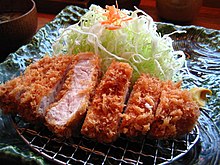
- Agemono (揚げ物): Deep-fried dishes
- Karaage (唐揚げ) : bite-sized pieces of chicken, fish, octopus, or other meat, floured and deep fried. Common izakaya (居酒屋) food, also often available in convenience stores.
- Nanbanzuke (南蛮漬け): marinated fried fish.
- Korokke (croquette コロッケ): breaded and deep-fried patties, containing either mashed potato or white sauce mixed with minced meat, vegetables or seafood. Popular everyday food.
- Kushikatsu (串カツ): skewered meat, vegetables or seafood, breaded and deep fried.
- Tempura (天ぷら): deep-fried vegetables or seafood in a light, distinctive batter.
- Tonkatsu (豚カツ): deep-fried breaded cutlet of pork (chicken versions are called chicken katsu).
- Karaage (唐揚げ) : bite-sized pieces of chicken, fish, octopus, or other meat, floured and deep fried. Common izakaya (居酒屋) food, also often available in convenience stores.
- Agedashi dofu (揚げ出し豆腐): cubes of deep-fried silken tofu served in hot broth.
Grilled and pan-fried dishes (yakimono, 焼き物)


- Yakimono (焼き物): Grilled and pan-fried dishes
- Gyoza (餃子): Chinese ravioli-dumplings (potstickers), usually filled with pork and vegetables (Spring onion, Leek, Cabbage, Garlic, and Ginger) and pan-fried.
- Kushiyaki (串焼き): skewers of meat and vegetables.
- Motoyaki (素焼き): Baked seafood topped with a creamy sauce.
- Okonomiyaki (お好み焼き): savory pancakes with various meat and vegetable ingredients, flavoured with the likes of Worcestershire sauce or mayonnaise.
- Takoyaki (たこ焼き, 蛸焼き): a spherical, fried dumpling of batter with a piece of octopus inside. Popular street snack.
- Teriyaki (照り焼き): grilled, broiled, or pan-fried meat, fish, chicken or vegetables glazed with a sweetened soy sauce.
- Unagi (鰻, うなぎ), including Kabayaki (蒲焼): grilled and flavored eel.
- Yakiniku ("grilled meat" 焼肉): may refer to several things. Vegetables such as bite-sized onion, carrot, cabbage, mushrooms, and bell pepper are usually grilled together. Grilled ingredients are dipped in a sauce known as tare before being eaten.
- Horumonyaki ("offal-grill" ホルモン焼き): similar homegrown dish, but using offal
- Jingisukan (Genghis Khan ジンギスカン) barbecue: sliced lamb or mutton grilled with various vegetables, especially onion and cabbage and dipped in a rich tare sauce. A speciality of Hokkaidō.
- Yakitori (焼き鳥): barbecued chicken skewers, usually served with beer. In Japan, yakitori usually consists of a wide variety of parts of the chicken. It is not usual to see straight chicken meat as the only type of yakitori in a meal.
- Yakizakana (焼き魚): flame-grilled fish, often served with grated daikon. One of the most common dishes served at home. Because of the simple cuisine, fresh fish in season are highly preferable. See Arabesque greenling
Nabemono (one pot "steamboat" cooking, 鍋物)
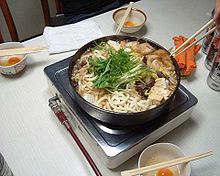
- Motsunabe (モツ鍋): beef offal, Chinese cabbage and various vegetables cooked in a light soup base.
- Shabu-shabu (しゃぶしゃぶ): hot pot with thinly sliced beef, vegetables, and tofu, cooked in a thin stock at the table and dipped in a soy or sesame-based dip before eating.
- Sukiyaki (すき焼き): thinly sliced beef and vegetables cooked in a mixture of soy sauce, dashi, sugar, and sake. Participants cook at the table then dip food into their individual bowls of raw egg before eating it.
- Chirinabe (ちり鍋): hot pot with fish and vegetables.
- Chigenabe (チゲ鍋) or Kimuchinabe (キムチ鍋): hot pot with meat, seafood and vegetables in a broth seasoned with gochujang, and Kimchi.
- Imoni (芋煮): a thick taro potato stew popular in Northern Japan during the autumn season
- Kiritanponabe (きりたんぽ鍋): freshly cooked rice is pounded, formed into cylinders around cryptomeria skewers, and toasted at an open hearth. The kiritanpo are used as dumplings in soups.
Nimono (stewed dishes, 煮物)

Nimono (煮物) is a stewed or simmered dish. A base ingredient is simmered in shiru stock flavored with sake, soy sauce, and a small amount of sweetening.[2]
- Oden (おでん, "kantou-daki", 関東炊き): surimi, boiled eggs, daikon radish, konnyaku, and fish cakes stewed in a light, soy-flavoured dashi broth. Common wintertime food and often available in convenience stores.
- Kakuni (角煮): chunks of pork belly stewed in soy, mirin and sake with large pieces of daikon and whole boiled eggs. The Okinawan variation, using awamori, soy sauce and miso, is known as rafuti (ラフテー).
- Nikujaga (肉じゃが): beef and potato stew, flavoured with sweet soy
- Nizakana (煮魚): fish poached in sweet soy (often on the menu as "nitsuke" (煮付け))
- Sōki (ソーキ): Okinawan dish of pork stewed with bone
Itamemono (stir-fried dishes, 炒め物)

Stir-frying (炒め物) is not a native method of cooking in Japan, however mock-Chinese stir fries such as yasai itame (stir fried vegetables, 野菜炒め) have been a staple in homes and canteens across Japan since the 1950s. Home grown stir fries include:
- Chanpurū (チャンプルー): A stir-fry from Okinawa, of vegetables, tofu, meat or seafood and sometimes egg. Many varieties, the most famous being gōyā chanpurū.
- Kinpira gobo (金平): Thin sticks of greater burdock (gobo, ゴボウ) and other root vegetables stir-fried and braised in sweetened soy.
Sashimi (刺身)

Sashimi (刺身) is raw, thinly sliced foods served with a dipping sauce and simple garnishes; usually fish or shellfish served with soy sauce and wasabi. Less common variations include:
- Fugu (河豚): sliced poisonous pufferfish (sometimes lethal), a uniquely Japanese specialty. The chef responsible for preparing it must be licensed.
- Ikizukuri (活き造り): live sashimi
- Tataki (たたき): raw/very rare skipjack tuna or beef steak seared on the outside and sliced, or a finely chopped raw fish (Japanese jack mackerel or Sardine), spiced with the likes of chopped spring onions, ginger or garlic paste.
- Basashi (馬刺し): horse meat sashimi, sometimes called sakura (桜), is a regional speciality in certain areas such as Shinshu (Nagano, Gifu and Toyama prefectures) and Kumamoto.[3] Basashi features on the menu of many izakayas, even on the menus of big national chains.
- Torisashi (鶏刺し): chicken breast sashimi, regional specialty of Kagoshima, Miyazaki prefectures.
- Rebasashi (レバ刺し): usually liver of calf, completely raw (rare version is called "aburi" (あぶり)), usually dipped in salted sesame oil rather than soy sauce.
Soups (suimono (吸い物) and shirumono (汁物))

Soups (suimono (吸い物) and shirumono (汁物)) include:
- Miso soup (味噌汁): soup made with miso dissolved in dashi, usually containing two or three types of solid ingredients, such as seaweed, vegetables or tofu.
- Tonjiru (豚汁): similar to Miso soup, except that pork is added to the ingredients
- Dangojiru (団子汁): soup made with dumplings along with seaweed, tofu, lotus root, or any number of other vegetables and roots
- Sumashijiru (澄まし汁) or osumashi (お澄まし): a clear soup made with dashi and seafood or chicken.
- Zoni (雑煮): soup containing mochi rice cakes along with various vegetables and often chicken. It is usually eaten at New Years Day.
Pickled or salted foods (tsukemono, 漬け物)
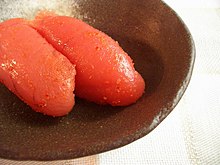

These foods are usually served in tiny portions, as a side dish to be eaten with white rice, to accompany sake or as a topping for rice porridges.
- Ikura (いくら): salt cured and pickled soy sauce salmon caviar.
- Tarako (たらこ): Salt-cured cod roe or pollock roe
- Shiokara (塩辛): salty fermented viscera.
- Tsukemono (漬物): pickled vegetables, hundreds of varieties and served with most rice-based meals.
- Tsukudani (佃煮): Very small fish, shellfish or seaweed stewed in sweetened soy for preservation.
- Sunomono (酢の物): vegetables such as cucumber or wakame, or sometimes crab, marinated in rice vinegar.
Miscellaneous (惣菜)

- Bento or Obento (弁当, 御弁当): combination meal served in a wooden box, usually as a cold lunchbox.
- Chawan mushi (茶碗蒸し): meat (seafood and/or chicken) and vegetables steamed in egg custard.
- Edamame (枝豆): boiled and salted pods of soybeans, eaten as a snack, often to accompany beer.
- Himono (干物): dried fish, often aji (Japanese jack mackerel, 鯵). Traditionally served for breakfast with rice, miso soup and pickles.
- Hiyayakko (冷奴): chilled tofu with garnish.
- Natto (納豆): fermented soybeans, stringy like melted cheese, infamous for its strong smell and slippery texture. Often eaten for breakfast. Typically popular in Kantō and Tōhoku but slowly gaining popularity in other regions in which Natto was not as popular
- Ohitashi (お浸し): boiled greens such as spinach, chilled and flavoured with soy sauce, often with garnish.
- Osechi (御節): traditional foods eaten at New Year.
- Japanese salad dressings
- Wafu dressing (和風ドレッシング): literally "Japanese-style dressing" is a vinaigrette-type salad dressing based on soy sauce, popular in Japan.
- Sanbaizu (三杯酢): The so-called vinegar that is blended with the ingredient here is often [[{{{1}}}]] (三杯酢, "three cupful/spoonful vinegar")[4] which is a blend of vinegar, mirin, and soy sauce.
Chinmi (珍味)
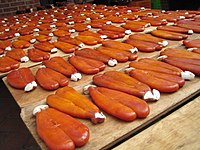
Chinmi (珍味) are regional delicacies, and include:
- Ankimo (あん肝)
- Karasumi (カラスミ)
- Konowata (このわた)
- Mozuku (モズク)
- Uni (ウニ): Specifically salt-pickled sea urchin
Although most Japanese eschew eating insects, in some regions, locust (inago, イナゴ) and bee larvae (hachinoko, 蜂の子) are not uncommon dishes.[citation needed] The larvae of species of caddisflies and stoneflies (zaza-mushi, ざざむし), harvested from the Tenryū river as it flows through Ina, Nagano, is also boiled and canned, or boiled and then sautéed in soy sauce and sugar.[citation needed] Japanese clawed salamander (Hakone Sanshōuo, ハコネサンショウウオ, Onychodactylus japonicus) is eaten as well in Hinoemata, Fukushima in early summer.[citation needed]
Sweets and snacks (okashi (おかし), oyatsu (おやつ))
Japanese-style sweets (wagashi, 和菓子)

Wagashi include
- Amanatto
- Dango: rice dumpling
- Hanabiramochi
- Higashi
- Hoshigaki: Dried persimmon fruit
- Imagawayaki: also known as 'Taikoyaki' is a round Taiyaki and fillings are same
- Kakigori: shaved ice with syrup topping.
- Kompeito: crystal sugar candy
- Manju: sticky rice surrounding a sweet bean center
- Matsunoyuki
- Mochi: steamed sweet rice pounded into a solid, sticky, and somewhat translucent mass
- Oshiruko: a warm, sweet red bean (an) soup with mochi: rice cake
- Uiro: a steamed cake made of rice flour
- Taiyaki: a fried, fish-shaped cake, usually with a sweet filling such as an: red bean paste
Old-fashioned Japanese-style sweets (dagashi, 駄菓子)
- Karumetou: Brown sugar cake. Also called Karumeyaki
- Sosu Senbei: Thin wafers eaten with sauce
- Mizuame: sticky liquid sugar candy
Western-style sweets (yōgashi, 洋菓子)
Yōgashi are Western-style sweets, but in Japan are typically very light or spongy.
- Kasutera: "Castella" Iberian-style sponge cake
- Mirukurepu: "mille crepe": layered crepe (in French, "one thousand leaves")
Sweets bread (kashi pan, 菓子パン)
- Anpan: bread with sweet bean paste in the center
- Melonpan: a large, round bun which is a combination of regular dough beneath cookie dough. It occasionally contains a melon-flavored cream, though traditionally it is called melon bread because of its general shape resembling that of a melon (not due to any melon flavor).
Other snacks
- See also List of Japanese snacks and Category:Japanese snack food
Snacks include:
- Azuki Ice: vanilla flavored ice cream with sweet azuki beans
- Koara no māchi
- Umai Bō Puffed corn food with various flavors
- Pocky
- Hello Panda
- Hi-chew
- Ice cream - usual flavours such as vanilla and chocolate are the most common. Distinctly Japanese ones include Matcha Ice (green tea ice cream), less common ones include Goma (black sesame seed) and sweet potato flavours.
Tea and other drinks
Tea and non-alcoholic beverages
- See also Japanese green teas and Japanese drinks
- Amazake
- Genmaicha: green tea combined with roasted brown rice.
- Gyokuro: Gyokuro leaves are shaded from direct sunlight for approximately 3 weeks before the spring harvest. Removing direct sunlight in this way enhances the proportions of flavenols, amino acids, sugars, and other substances that provide tea aroma and taste. After harvesting the leaves are rolled and dried naturally. Gyokuro is slightly sweeter than sencha and is famous for its crisp, clean taste. Major growing areas include Uji, Kyōto and Shizuoka prefecture.
- Hojicha: green tea roasted over charcoal.
- Kombucha (tea): specifically the tea poured with Kombu giving rich flavor in monosodium glutamate.
- Kukicha: a blend of green tea made of stems, stalks, and twigs.
- Kuzuyu: a thick herbal tea made with kudzu starch.
- Matcha: powdered green tea. (Green tea ice cream is flavored with matcha, not ocha.)
- Mugicha: barley tea, served chilled during summer.
- Sakurayu: an herbal tea made with pickled cherry blossoms.
- Sencha: steam treated green tea leaves then dried.
- Umecha: a tea drink with umeboshi giving refreshing sourness.
Soft drinks
Alcoholic beverages
- Awamori (泡盛)
- Sake (酒, 日本酒)
- Shōchū (焼酎)
- Umeshu (梅酒)
- Japanese beer (ビール) - leading brands are Sapporo, Asahi and Kirin
Imported and adapted foods
Japan has incorporated imported food from across the world (mostly from Asia, Europe and to a lesser extent the Americas), and have historically adapted many to make them their own.
Foods imported from Portugal in the 16th century
- Tempura - so thoroughly adopted that its foreign roots are unknown to most people, including many Japanese. As such, it is considered washoku.
- castella - sponge cake, originating in Nagasaki
- Pan is bread, introduced by Portugal. (Bread is Pão in Portuguese.) Japanese bread crumbs, panko, have been popularized by cooking shows.
Yōshoku
Yōshoku (洋食) is a style of Western-influenced food.
- Breaded seafood or vegetables (furai, フライ, derived from "fry"), and breaded meat (katsuretsu, カツレツ, derived from "cutlet" and often contracted to katsu), are usually served with shredded cabbage and/or lettuce, Japanese Worcestershire or tonkatsu sauce and lemon. Tempura, a related dish, has been heavily modified since its introduction to Japan by use of batter and dashi-flavored dip, and is usually considered to be washoku (和食, native food).

- Kaki furai (カキフライ, 牡蠣フライ) - breaded oyster
- Ebi furai (エビフライ, 海老フライ) - breaded shrimp
- Korokke ("croquette" コロッケ) - breaded mashed potato and minced meat patties. When white sauce is added, it is called cream korokke. Other ingredients such as crab meat, shrimp, or mushrooms are also used instead of minced meat which are called kani-, ebi-, or kinoko-cream korokke, respectively.
- Tonkatsu, Menchi katsu, chicken katsu, beef katsu, kujira katsu - breaded and deep-fried pork, minced meat patties, chicken, beef, and whale, respectively.
- Japanese curry-rice - imported in the 19th century by way of the United Kingdom and adapted by Japanese Navy chefs. One of the most popular food items in Japan today. Eaten with a spoon. Curry is often eaten with pickled vegetables called fukujinzuke or rakkyo
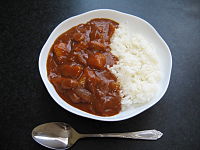
- Hayashi rice (ハヤシライス) - beef and onions stewed in a red-wine sauce and served on rice
- Nikujaga - soy-flavored meat and potato stew. Has been Japanised to the extent that it is now considered washoku, but again originates from 19th Century Japanese Navy chefs adapting beef stews of the Royal Navy.
- Omu raisu - ketchup-flavored rice wrapped in omelet.
Other items were popularized after the war:
- Hamburg steak - a ground beef patty, usually mixed with breadcrumbs and fried chopped onions, served with a side of white rice and vegetables. Popular post-war food item served at homes. Sometimes eaten with a fork.



- Spaghetti - Japanese versions include:
- with tomato ketchup, wieners, sliced onion and green pepper (called "naporitan" or "napolitan")
- with mentaiko sauce topped with nori seaweed (Tarako Spaghetti たらこスパゲッティ) (Mentaiko Spaghetti 明太子スパゲッティ)
- with Japanese curry
Other homegrown cuisine of foreign origin
- Japanese American cuisine
- Burgers have various variations in Japan. MOS Burger developed Teriyaki Burgers and kinpira rice burger
- Korean cuisine
- Kimchi - from Korea is often served with Japanese Chinese cuisine, though the local variant may use thinner cabbage.
- Japanese Chinese cuisine
- Ramen and related dishes such as champon and yaki soba
- Mābō Dōfu tends to be thinner than Chinese Mapo doufu.
- Japanese-only "Chinese dishes" like Ebi Chili (shrimp in a tangy and slightly spicy sauce)
- Nikuman, anman, butaman and the obscure negi-man are all varieties of mantou with fillings.
- Gyoza are a very popular dish in Japan. Gyoza are the Japanese take on the Chinese dumplings with rich garlic flavor. Most often, they are seen in the crispy pan-fried form (potstickers), but they can be served boiled or even deep fried, as well.
- Japanese English cuisine
- Purin is a version of caramel custard.
Adaptations
- California roll - invented in California, just as its name suggests
- Spam musubi - a snack from Hawaii resembling onigiri made with Spam.
Japanese flavorings
Many Japanese foods are prepared using one or more of the following:
- Kombu (kelp), katsuobushi (flakes of cured skipjack tuna, sometimes referred to as bonito) and niboshi (dried baby sardines) are often used to make dashi stock.
- Negi (Welsh onion), onions, garlic, nira (Chinese chives), rakkyō (a type of scallion).
- Sesame seeds, sesame oil, sesame salt (gomashio), furikake, walnuts or peanuts to dress.
- Shōyu (soy sauce), dashi, mirin, sugar, rice vinegar, miso, sake.
- Wasabi (and imitation wasabi from horseradish), karashi (hot mustard), red pepper, ginger, shiso (perilla or beefsteak plant) leaves, sansho, citrus peel, and honeywort (called mitsuba).
- A citrus fruit called yuzu is also a frequent condiment, mashed up into a relish, sold as yuzukoshō and is blended with pepper/chili and salt. Yuzukoshō is eaten with many dishes, adding a flavorful kick to broth/soup items such as oden, nikujaga, tonjiru, udon as well as other dishes. Yuzu is also seen to flavor teas, jams or zeri (jelly), and any number of sweets from yuzu-an (a type of Anpan) to yuzu-hachimitsu (yuzu-honey).
Less traditional, but widely used ingredients include:
- Monosodium glutamate, which is often used by chefs and food companies as a cheap flavor enhancer. It may be used as a substitute for kombu, which is a traditional source of free glutamate
- Japanese-style Worcestershire sauce, often known as simply "sauce", thicker and fruitier than the original, is commonly used as a table condiment for okonomiyaki (お好み焼き), tonkatsu (トンカツ), croquette ("korokke", コロッケ) and the like.
- Japanese mayonnaise is used with salads, okonomiyaki (お好み焼き), yaki soba (焼きそば) and sometimes mixed with wasabi or soy sauce.
See also
References
- ^ Stanlaw, James (2004). Japanese English: language and culture contact. Hong Kong University Press. p. 46. ISBN 962-209-572-0.
- ^ Hosking, Richard (2000). At the Japanese Table. Images of Asia. New York: Oxford University Press. p. 12. ISBN 978-0-195-90980-7. LCCN 00058458. OCLC 44579064.
- ^ http://www.quirkyjapan.or.tv/food.html
- ^ Shimbo 2000, p.147 "wakame and cucumber in sanbaizu dressing (sunomono)"; p.74 "sanbaizu" recipe
